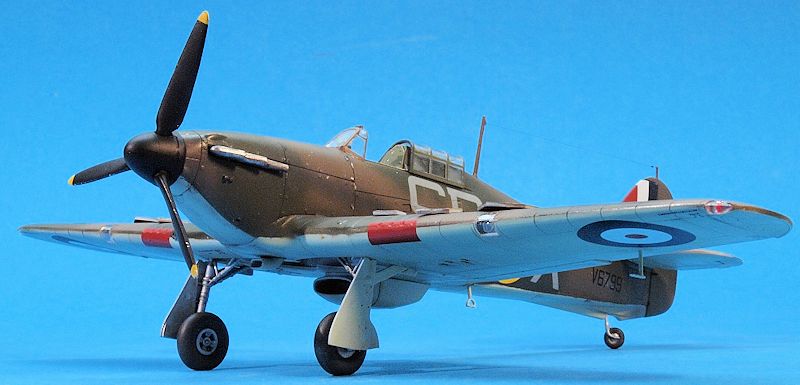
Airfix 1/48 Hurricane I
| KIT #: | A05127 |
| PRICE: |
@22 Euros |
| DECALS: | Two options |
| REVIEWER: | Frank Spahr |
| NOTES: |
|

| HISTORY |
There
is nothing I could add to what has been written by much more competent
contributors on the iconic Hawker Hurricane fighter. This partly fabric-covered
monoplane bore the brunt of the Battle of Britain and yet remained in the shadow
of the more modern, all-metal Supermarine Spitfire. Hurricanes continued to
serve for years throughout the conflict and also played an important role in
bringing airpower to the Atlantic convoys, but their performance in the summer
of 1940 is what made them the legend they are.
| THE KIT |
My
situation this year is like that of a fan of some obscure rock band or football
team. One of the sort that has seen better days and faded not quite into
oblivion, but into the ignominy of performing
in
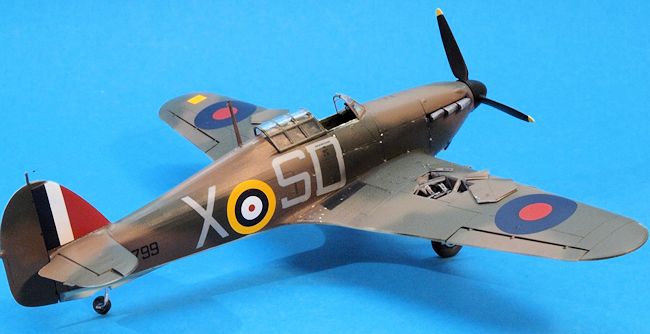 obscure venues with lacklustre results, all the while distressing
their loyal supporters that find it ever harder to rose-tint what they see. And
then, ka-BOOM, the band is injected by a seismic amount of creativity, the
football team is bought by some plutocrat that actually has some sense for what
the audience wants, they release a new album that rocks the charts, the team
rises from some minor league in the sticks to nationwide fame, back into the
spotlight.
obscure venues with lacklustre results, all the while distressing
their loyal supporters that find it ever harder to rose-tint what they see. And
then, ka-BOOM, the band is injected by a seismic amount of creativity, the
football team is bought by some plutocrat that actually has some sense for what
the audience wants, they release a new album that rocks the charts, the team
rises from some minor league in the sticks to nationwide fame, back into the
spotlight.
Same - to me - with Airfix. Since they went into administration and were taken
over by Hornby, a change has set in, and the current catalogue is vivid
testimonial that they are actively updating their entire range of planes and
vehicles to a new standard that is finally on par with the competition. This
year´s 75th anniversary of the Battle of Britain sees this new Hurricane Mk.I
kit after their earlier release of a Spitfire Mk.I, and they are complemented by
a set of ground equipment and figures, plus a tanker and a medium truck, all in
1:48 scale. Whilst the early new releases received heavy flak due to their
perceived heavy-handed engraved details, these new 1:48 kits have been received
very warmly on model review sites.
With myself anything but a Hurricane boffin, but rather a hopeless Airfix
supporter and Anglophile, I am unable to comment on the finer points of ye aulde
accuracy of this kit, and I unable to comment without bias. I can but report on
how the kit built on my workbench. I built it over a week and a half next to
work, with most hours thrown in on the weekends. It was built mostly OOB. The
only aftermarket items were
 Eduard coloured PE seatbelts and one small generic
PE part by Saemann I used as eyelet on the aerial mast.
Eduard coloured PE seatbelts and one small generic
PE part by Saemann I used as eyelet on the aerial mast.
First of all, the kit is very well molded. There are some ejector pin marks that
might show up to a pen-light in the lower reaches of the cockpit, though. These
were filled with CA glue. There was one sink mark on the port stabilizer root,
which I also filled. The sprues were well-packed and the top-opening box not
overly cramped.
I
am very happy with the new-style instructions. They are very clear and show you
in red where some part needs to end up. They are mostly in sensible assembly
sequence. They properly show build options. They are uncluttered. In short, they
are virtually as one would wish them, short of the full-colour splendour of
Wingnut Wings. But then, this is an easily affordable kit, at a bit over 20
Euros. As Revell has their penchant for their own paint range, Airfix still only
lists Humbrol paint numbers in their instructions, but at least offers clear
names to the main shades in the colour profiles.
| CONSTRUCTION |
Construction did start with the cockpit, and stayed there for quite some while,
as you get a good part of the tubular inner structure and two wing spars. You´ll
end up with the correct bottomless cockpit and some pretty well detailed wheel
wells. I opened the access panels to the gun bays at this early stadium, too. As
I wanted to build a plane undergoing servicing, the quite nice pilot figure
would not be used, and I
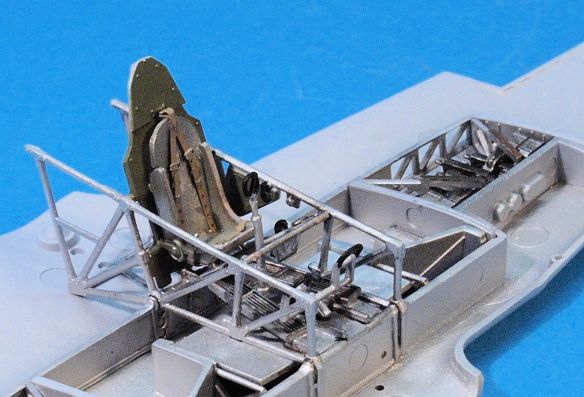 added a set of hopefully appropriate seatbelts from a
friend´s spares box. Everything went together really well, and I soon was able
to add some paint to the interior.
added a set of hopefully appropriate seatbelts from a
friend´s spares box. Everything went together really well, and I soon was able
to add some paint to the interior.
This model was painted as follows: All the parts were sprayed with lighter fluid
for de-greasing, and then primed with Vallejo´s PU primer. Paints used were
Vallejo Model Air for aluminium and black and the appropriateXtracrylix shades
for the interior and the camo scheme. The primer held up well on the plastic and
I did not experience any embarrassing paint liftoffs.
I
was pretty soon able to mate the cockpit/wing spar assembly to the lower wing,
and experienced a satisfying fit. Next came filling the gun bays with the eight
Brownings and their ammo feeds. These
parts are quite nice from the box and were good enough for me, even
though I´m sure there will be some impressive aftermarket offerings with
increased detail. I used AK interactive´s True Metal Paste to advantage here,
plus some dark washing.
The next real test of the fit came when the upper wings were glued to the lower
wing assembly. Some minor sanding of the boxes surrounding the gun bays sufficed
to achieve a good fit. While this dried, the fuselage halves were prepared.
There is limited sidewall detail and a structured instrument panel, and a
firewall blocking the view into the hollow area where the engine would sit. This
was duly painted and the I.P. decaled, which rendered a credible result. The
fuselage halves were then mated and also fit really well. Next came the real
test of the kit´s fit, mating the fuselage to the wing/cockpit. It was quite
helpful that the fuselage was open on the underside at this stage, as I was able
to apply glue from there. The rather complex shapes and contours all lined up
pretty well, and in the end I only needed some limited amount of CA glue to fill
some very small seams. I was impressed by this fit, and quite happy.
You get some quite neat extra parts with this kit, namely an optional underside
with arrestor hook for the Sea Hurricane, and an optional chin underside with
the Vokes sand filter for your tropical needs. Apart from the later cannon-armed
planes, you can build a lot of Hurricanes from this kit, as it also contains two
different propellors and wheel
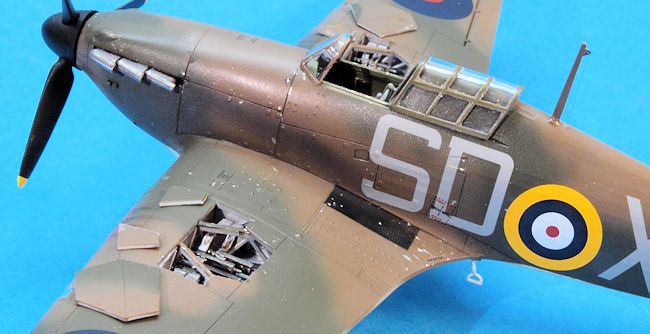 hubs with differently shaped faces that can be
installed as needed.
hubs with differently shaped faces that can be
installed as needed.
The fuselage inserts I needed were of the early, common or garden variety and
fit well. Having closed the fuselage, I completed my seam work and masked the
cockpit. Ailerons, stabilizers and rudder were now added and also fit well.
Now it was time to address the remaining bits of varying fiddliness. This
comprised the oil cooler with some fiddly actuators, the nicely detailed landing
gear, the wheels and their separate (!!) hubs, the exhausts and the prop. The
exhausts were carefully drilled open and painted True Metal with some dark red
drybrushing. The prop assembly fit well and was painted. The clear gunsight was
also painted at this stage. The landing light covers had been installed right
when building the wings and were masked then. The navigation lights had small
holes drilled carefully from their rear face, and filled with red and green
paint respectively.
There are two canopy parts of different width for use in the open and closed
position, which is quite helpful. Eduard has announced canopy masks for this
kit, but as I was in a kind of modeling frenzy at that stage I did not quite
like waiting for them to reach me. So I used a sharp #11 blade and masked away.
| COLORS & MARKINGS |
I
started with pre-shading the panel lines with black, and then sprayed the
underside and wheel well covers Sky. This was duly masked and the uppersides
then sprayed in camo. I had started around the gun bay covers with hard masking,
but didn´t really like the effect. I felt I should do soft masking, but didn´t
quite feel up to the task and wouldn´t want to ruin things with some paint
disaster. So, despite knowing that Huricanes were mostly painted with rubber
paint masks, I freehanded the camo, which is
 not correct, but looked less toylike than my attempts at hard masking.
not correct, but looked less toylike than my attempts at hard masking.
The underside masking removed, the model was checked for faults, some touchups
were made, and then I applied Johnson´s Klear to give me a good base for
decaling. That cured (I continued work on the remaining fiddly bits in the
meantime) I applied first the underside decals and then the upperside ones. I
quite liked the red tape decals to cover the gun muzzles, even though the decal
film is on the stronger side and less amenable to setting solutions, so it did
not easily conform to the openings I had drilled out earlier. This property of
the decals was annoying but turned out to be a blessing in disguise pretty soon.
All decals applied, I belatedly decided to spray the black walkway areas on the
wingroots instead of using the kit decals. That necessitated masking their
surrounds, and even though I apply any masking tape to a glass pane prior to
applying it to the model, I managed to tear off the lower half of the right side
squadron code on de-masking.
Arrff.
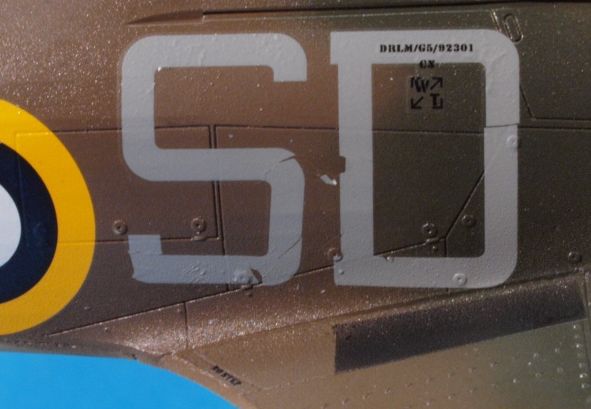 Sitting there with half the decal on the masking tape, I managed not to explode
and soaked the tape in water until it was quite soft. The rather strong decal
material enabled me to very carefully pull it off over some ten minutes of
careful work, and I was able to re-apply it with only limited damage. That
damage was painted over with one of my sizable collection of greys (less than
fifty, though), and I was able to seal the decals first with more Klear, then
with Windsor & Newton´s Galleria flat acrylic varnish.
Sitting there with half the decal on the masking tape, I managed not to explode
and soaked the tape in water until it was quite soft. The rather strong decal
material enabled me to very carefully pull it off over some ten minutes of
careful work, and I was able to re-apply it with only limited damage. That
damage was painted over with one of my sizable collection of greys (less than
fifty, though), and I was able to seal the decals first with more Klear, then
with Windsor & Newton´s Galleria flat acrylic varnish.
Next came weathering and accentuating the model. I used artist´s oils for wear
and tear and slight gunsmoke staining, and True Metal for paint chipping. Some
washing, some pin washes, some drybrushing later I called it quits. The exhaust
marks were sprayed with dark grey Vallejo ModelAir paint. The rest of that day
was spent painting the canopy and installing it, and adding the landing gear,
prop, navigation lights and antenna mast. The aerial was made from ultrafine
Caenis monofilament. The rearview mirror which is missing from the kit was made
from some styrene stock and painted accordingly.
| CONCLUSIONS |
This is a most delightful kit that brought back the fun and joy of building
plastic models to me after a protracted slog through a 1:700 resin kit with
loads of delicate PE. I need something like that from time to time, and it sure
hit the right spot. I´m currently working on the Albion Fueller and am looking
forward to my small Battle of Britain vignette.
Now if only Airfix would direct the same dedication to producing some new ship
models, I´d be happy as a pig in a really large pool of mud!
June 2015
If you would like your product reviewed fairly and fairly quickly, please contact the editor or see other details in the Note to Contributors.